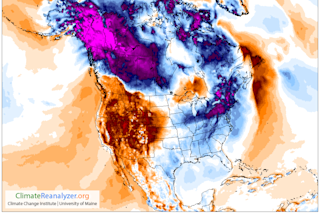Temperature anomaly forecast for North America on Friday, Feb. 6. (Source: Climate Reanalyzer, http://cci-reanalyzer.org, Climate Change Institute, University of Maine, USA) Dateline —Niwot, Colorado,Feb. 6, 2015, 9:30 p.m.:
Temperature: 65 degrees F. Normal low for this date: ~ 20.
Dateline —New York City, Feb. 6, 2015:
Low temperature for the day: 16 degrees. Normal low: ~28
Dateline — Eureka, CA, Feb. 7, 2015:
From KIEM TV: "Fifteen families have been stranded and several students relocated after weather related washouts and slides hit the North Coast. Fox Creek in Carlotta destroyed part of a private road taking out pavement and creating an almost 20 foot gap where that road used to be. It left families wondering what to do."
Yes indeed, it sure seems weird outside. But if you need additional evidence, check out this photograph:
Ice floes on the Hudson River? Really? (iPhone photograph courtesy Claire Cornish) My friend Claire ...














